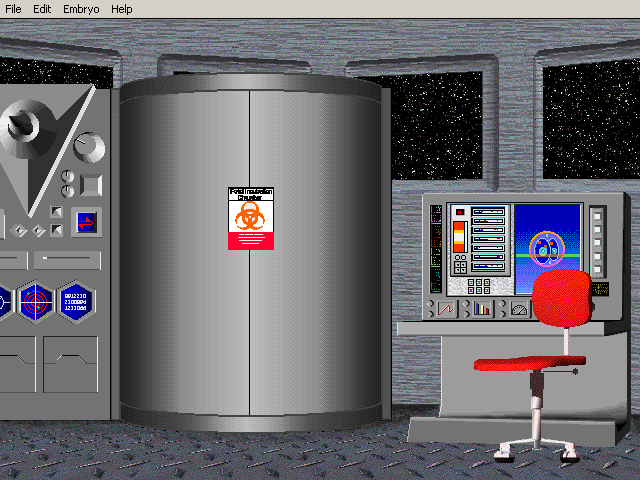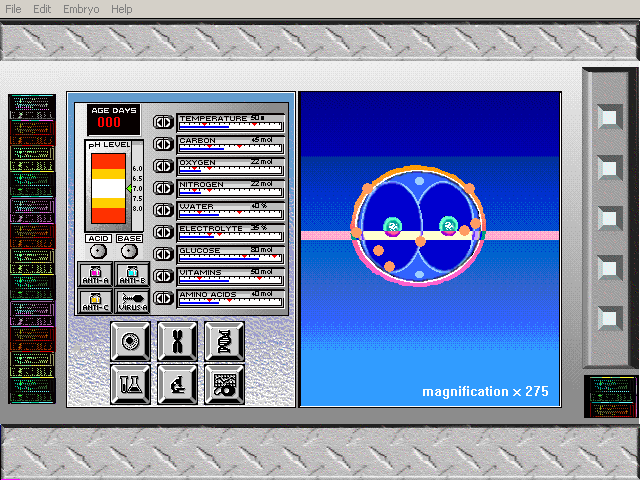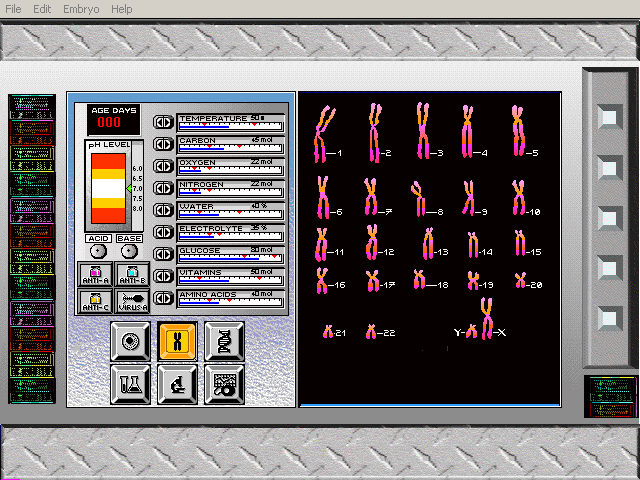Retro Replay Review
Gameplay
G-Netix places you in the captain’s chair of a cutting-edge orbital laboratory, where every decision you make directly shapes the course of human life. Your primary tools are environmental sliders—oxygen concentration, pH balance, hydrogen levels—and a gene-editing console that lets you splice, duplicate, or remove individual chromosomes. The tactile satisfaction of tweaking a parameter and watching the embryo respond in real time creates a compelling feedback loop: succeed in fostering healthy cell division and complex tissue structures, or push the organism to the brink of extinction with a single miscalculation.
(HEY YOU!! We hope you enjoy! We try not to run ads. So basically, this is a very expensive hobby running this site. Please consider joining us for updates, forums, and more. Network w/ us to make some cash or friends while retro gaming, and you can win some free retro games for posting. Okay, carry on 👍)
Each experiment in G-Netix feels like a delicate puzzle: a mutation in one gene can trigger cascading effects across multiple systems, from cardiovascular development to sensory organ formation. The game’s UI keeps you in constant dialogue with your creation, presenting growth curves, viability indicators, and visual snapshots of morphology. When you notice an unusual trait—say, insect-like eyes or an accelerated heart rate—you’re prompted to investigate the underlying genetic tweak, making every playthrough a detective story as much as a simulation.
Beyond the sandbox mode, G-Netix offers scenario-based challenges that guide you through increasingly complex objectives: rescue a virus-damaged embryo, engineer an extremophile that can survive in low-oxygen environments, or induce reversible mutations to study their effects. These curated experiments serve as a gentle tutorial for newcomers, while seasoned players can dive into the fully open genetic playground. The balance between structured goals and freeform creation ensures that both educational institutions and hobbyists will find plenty of replay value.
Graphics
The visual presentation in G-Netix is surprisingly polished for a science-heavy simulation. High-resolution cell renders and dynamic lighting give each microscopic environment a sense of depth, as if you’re peering through an advanced digital microscope. Textures on the embryo’s surface change smoothly as layers of skin, tissue, and organ systems develop. Even subtle phenomena—like minute shifts in cell membrane tension or the flicker of cellular organelles—are brought to life with crisp detail.
Complementing the close-up cellular views, the game features an atmospheric space-station backdrop, with panoramic windows revealing Earth’s curvature and distant stars. The contrast between the sterile, high-tech interior and the organic chaos unfolding under your direction lends an almost cinematic quality to every session. Contextual data panels and 3D gene-mapping graphs slide in and out of view seamlessly, ensuring that you’re never overwhelmed by raw numbers.
Performance remains steady across a wide range of hardware configurations, thanks to well-optimized shaders and level-of-detail scaling for 3D models. On mid-range systems, you can maintain a smooth 60 fps even during the most mutation-intense sequences, while high-end rigs can push beautiful anti-aliased visuals at ultra settings. Occasional frame dips may occur when simulating thousands of cells simultaneously, but these moments are brief and never disrupt the overall flow.
Story
The narrative spine of G-Netix revolves around a lone scientist hurtling through space as Earth succumbs to a lethal virus. With humankind wiped out in mere days, you inherit the last hope for life’s continuity. This setup injects a poignant urgency into the gameplay, transforming what could feel like a sterile lab exercise into a mission of almost divine importance. Your personal logs and audio diaries gradually reveal the scientist’s motivations, fears, and reflections on playing god with genetic codes.
As you progress, the story unfolds through radio transmissions, fragmented research notes, and encounters with strange cosmic phenomena that hint at unforeseen variables in your experiments. These narrative beats introduce moral quandaries: should you engineer for maximum survivability at the cost of individuality? What happens if you push an embryo beyond Earth-like conditions? G-Netix rarely spoon-feeds answers; instead, it trusts you to piece together lore from scattered clues and interpret the ethical implications of each genetic twist.
Although the main campaign is relatively compact—designed to be completed in around 10–12 hours—it’s dense with narrative content that rewards careful reading. If you’re the type of player who enjoys emergent storytelling through gameplay outcomes, you’ll appreciate how each unexpected mutation or organismal failure feels like part of a larger, unfolding saga. In this way, G-Netix crafts a story that’s as much about scientific discovery as it is about human stewardship.
Overall Experience
G-Netix stands out as a remarkable fusion of hardcore science and accessible gameplay. Its innovative premise—reshaping life at its most fundamental level—offers a depth of engagement rarely seen in the genre. Whether you’re fascinated by genetics, biology, or simulation games, the thrill of coaxing a single cell into a thriving organism never grows old. The educational backbone, supported by the bundled genetics summary covering DNA replication, mutation, and cell division, makes it equally at home in a classroom or a personal gaming library.
That said, the very complexity that makes G-Netix compelling can also overwhelm. Casual players might find the learning curve steep, and some of the more advanced gene-editor features can feel opaque without frequent reference to the in-game encyclopedia. A handful of tutorial enhancements—such as guided mutation walkthroughs or real-time pop-up tips—would help smooth the onboarding process for newcomers.
Ultimately, G-Netix delivers a rich, thought-provoking experience that transcends conventional simulation titles. Its seamless blend of challenge, discovery, and narrative purpose ensures that each experiment feels meaningful. For players eager to explore the frontiers of synthetic biology or simply enjoy a deep, meditative sandbox, G-Netix is a rare and rewarding voyage into the very code of life itself.
 Retro Replay Retro Replay gaming reviews, news, emulation, geek stuff and more!
Retro Replay Retro Replay gaming reviews, news, emulation, geek stuff and more!








Reviews
There are no reviews yet.